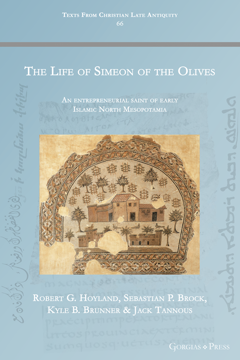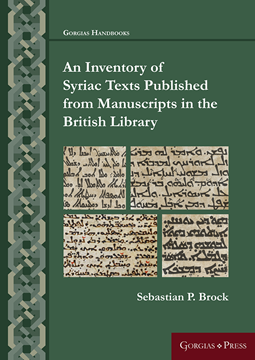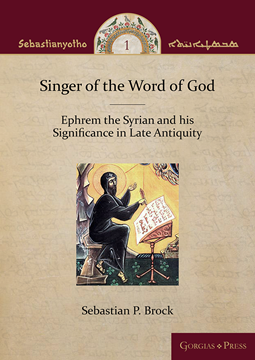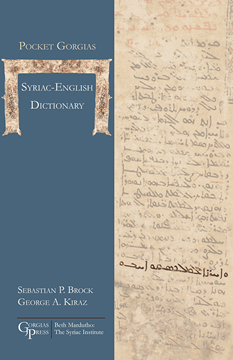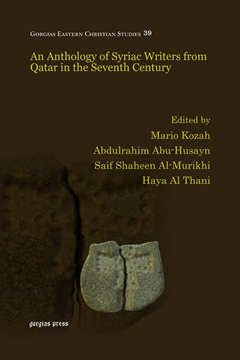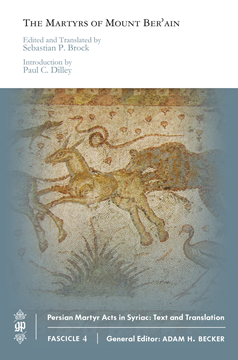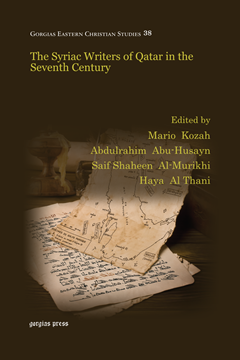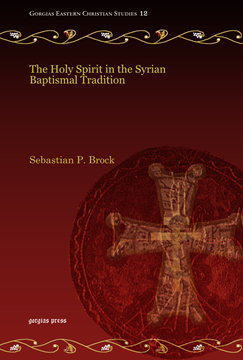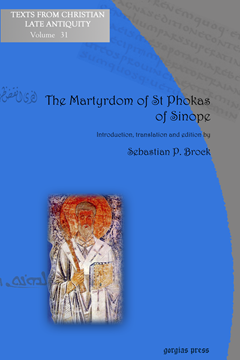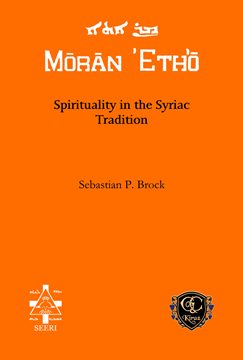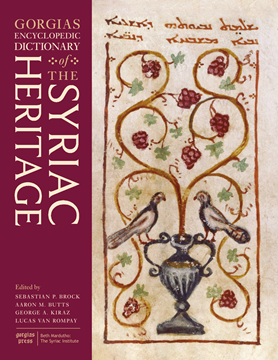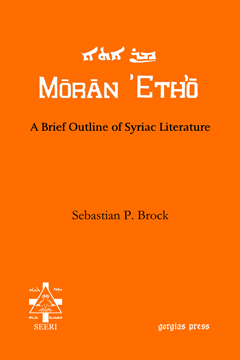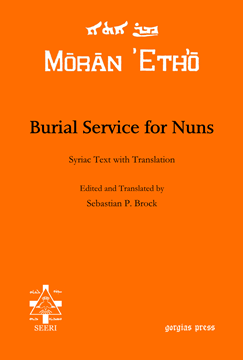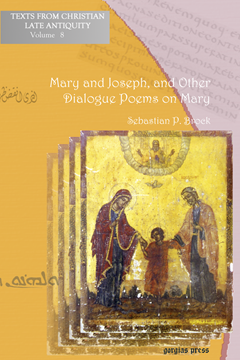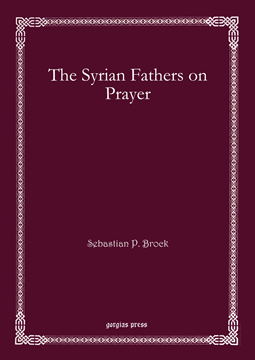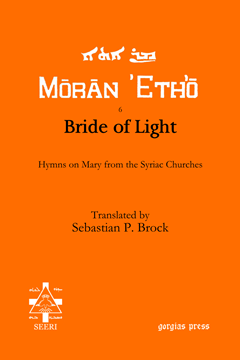Sebastian P. Brock

Emeritus Reader in Syriac Studies, Oxford University, and Emeritus Fellow of Wolfson College, Oxford. Author of a number of contributions in the area of Syriac studies (including several books published by Gorgias Press).
The Stanzaic Poems of Jacob of Serugh
A Collection of His Madroshe and Sughyotho
Series: Texts from Christian Late Antiquity 72
ISBN: 978-1-4632-4430-9
Although the verse homilies of Jacob of Serugh are well known to lovers of Syriac literature, his stanzaic poetry, in the form of madroshe and sughyotho, have been largely forgotten. This volume contains twenty-five poems preserved in their complete form and attributed to Jacob in old manuscripts of the sixth/seventh to ninth/tenth century preserved today in the British Library, but largely originating from Deir al-Surian in Egypt.
$59.00 (USD) $35.40 (USD)
Life of the Blessed Virgin Mary
Translated from Syriac to Malayalam by Rev. Fr. Kuriyakos Pallikkapparambil (1926 AD); Translated from Malayalam to English by Sarah Knight; With a Foreword by Sebastian P. Brock
Series: Texts from Christian Late Antiquity 68
ISBN: 978-1-4632-4355-5
Different parts of the Life of the Blessed Virgin Mary are known from the second century onwards. Translations and adaptations into Syriac and other languages also became available from very early centuries. The compilation in the Syriac language was translated into Malayalam in 1925, but an English translation containing the full text did not exist at all. This gap has been filled now by this work. Sebastian Brock’s Foreword gives important information on the background and authenticity of the different sources that form the basis of the text. This biography is unique in that it brings together some very early accounts of the birth of Mary, the birth of Jesus, the flight into Egypt, and most importantly, the very rare account of the ‘Dormition’ or ‘falling asleep’ of the Blessed Mother.
$55.00 (USD) $33.00 (USD)
The Life of Simeon of the Olives
An entrepreneurial saint of early Islamic North Mesopotamia
Series: Texts from Christian Late Antiquity 66
ISBN: 978-1-4632-4346-3
The first ever critical edition and complete translation of the Syriac Life of Saint Simeon of the Olives, who was an abbot of Qartmin Monastery in Tur Abdin and a bishop of the city of Harran in the late seventh and early eighth century AD.
$50.00 (USD) $30.00 (USD)
The Bible in the Syriac Tradition (Third Edition)
Series: Gorgias Handbooks 52
ISBN: 978-1-4632-4233-6
This is a basic introduction to the various Syriac translations of the Bible and the ways in which they were used in the Syriac tradition. After an initial discussion of the general problems of biblical translation, the different surviving Syriac translations are outlined, as well as biblical manuscripts, lectionaires, printed editions, and translations. A reception history of the Syriac Bible covers the ways in which it has been interpreted, the commentary tradition, its use in preaching, in liturgy, and in spirituality. An appendix offers some comparative samples (in translation) to illustrate some of the differences between the different Syriac translations.
$53.00 (USD) $31.80 (USD)
An Inventory of Syriac Texts Published from Manuscripts in the British Library
Series: Gorgias Handbooks 50
ISBN: 978-1-4632-4214-5
The British Library possesses one of the most important collections of Syriac manuscripts in the world, with large numbers dating back to the second half of the first millennium CE. The publication of important Syriac texts from these manuscripts has been going on for some 180 years and still continues. The aim of the present volume is to provide a guide to these scattered publications: following the sequence of the shelf-marks (call numbers), for each manuscript indication is given of what texts have been published from it. For convenience, a concordance between Wright’s Catalogue numbers and shelf-marks is provided, along with a list of palimpsests and of joins with manuscripts in other libraries, in particular with those still in the Library of Dayr al-Surian in Egypt, the monastery which was the source of over 500 manuscripts and fragments purchased by the British Museum in the mid nineteenth century.
$149.00 (USD) $89.40 (USD)
Gorgias Illustrated Learner's Syriac-English, English-Syriac Dictionary
Series: Gorgias Handbooks 46
ISBN: 978-1-4632-4180-3
The Gorgias Illustrated Learner's Syriac English, English-Syriac Dictionary is both a convenient academic resource and a door into the world of Modern Literary Syriac. With 13,000 entries drawn from the major existing works, alongside dozens of explanatory boxes on biblical, historical, theological, liturgical, cultural, as well as grammatical topics, and over 80 colored illustrations, it is a practical tool for those that wish to access all but the most specialized Classical Syriac texts.
$48.00 (USD)
Singer of the Word of God
Ephrem the Syrian and his Significance in Late Antiquity
Series: Sebastianyotho 1
ISBN: 978-1-4632-3922-0
As the first volume of the Sebastianyotho series, this book collects Sebastian P. Brock’s articles related to Ephrem the Syrian.
$179.00 (USD) $107.40 (USD)
An Introduction to Syriac Studies (Third Edition)
Series: Gorgias Handbooks
ISBN: 978-1-4632-0713-7
This Introduction aims to provide basic guidance to important areas of Syriac studies. The relevance of Syriac studies to a variety of other fields is explored. A brief orientation to the history of Syriac literature is offered, and Syriac is set within the context of the other Aramaic dialects. A thorough discussion on important tools (Instrumenta Studiorum) is presented; topics include grammars, dictionaries, the Bible in Syriac, histories of Syriac literature, bibliographical aids and relevant series, periodicals, and encyclopedias. This Introduction should prove useful both for the student beginning Syriac studies and for scholars working in adjacent fields.
$39.00 (USD)
Pocket Gorgias Syriac-English Dictionary
Series: Gorgias Handbooks 38
ISBN: 978-1-4632-0707-6
The Pocket Dictionary is both a convenient academic resource and a door into the world of Modern Literary Syriac. With 13,000 entries drawn from the major existing works, it is a practical tool for all but the most specialized Classical Syriac texts.
$45.00 (USD)
Jacob of Sarug's Homilies on Women Whom Jesus Met
Edited and Translated by Susan Ashbrook Harvey, Sebastian P. Brock, Professor Reyhan Durmaz, Rebecca Stephens Falcasantos, Michael L. Payne & Prof. Daniel Picus
Series: Texts from Christian Late Antiquity 44
ISBN: 978-1-4632-0580-5
Five homilies by Jacob of Sarug on women whom Jesus met: the Canaanite Woman, the Samaritan Woman, the Hemorrhaging Woman, the Woman Bent Double, and Jairus' Daughter.
$37.00 (USD) $22.20 (USD)
Diccionario Gorgias Siriaco-Español
By Sebastian P. Brock & George Anton Kiraz; Edición y traducción española de Joan Ferrer & Juan Pedro Monferrer-Sala
Series: Gorgias Handbooks 34
ISBN: 978-1-4632-0600-0
El Diccionario Gorgias Siriaco-Español, basado en el Gorgias Concise Syriac-English, English-Syriac Dictionary de Brock y Kiraz, ha sido concebido como un recurso académico, concebido tanto para el siriaco clásico como para el siriaco literario moderno. A Concise Syriac-Spanish Dictionary. Based on Brock and Kiraz's 2015 Gorgias Concise Syriac-English, English-Syriac Dictionary, it is designed to be a convenient academic resource for Classical Syriac.
$48.00 (USD)
An Anthology of Syriac Writers from Qatar in the Seventh Century
Series: Gorgias Eastern Christian Studies 39
ISBN: 978-1-4632-0545-4
The Syriac writers of Qatar have not received the scholarly attention that they deserve in the last half century. This anthology seeks to redress such an underdevelopment by providing new material in English translation with accompanying Syriac and Garshuni editions to encourage further research in the sub-field of Beth Qatraye studies. It includes the work of some of the most prominent scholars in this field.
$25.00 (USD)
The Martyrs of Mount Ber'ain
Edited and Translated by Sebastian P. Brock; Introduction by Paul C. Dilley
ISBN: 978-1-4632-0421-1
The Martyrs of Mount Ber’ain is the poignant tale of three noble Iranian siblings who are martyred under Shapur II. Composed in the seventh century, it demonstrates enduring concerns of Christian self-definition in Iran, especially with respect to the Zoroastrian priesthood.
$43.00 (USD) $25.80 (USD)
The Syriac Writers of Qatar in the Seventh Century
Series: Gorgias Eastern Christian Studies 38
ISBN: 978-1-4632-0355-9
The Syriac writers of Qatar themselves produced some of the best and most sophisticated writing to be found in all Syriac literature of the seventh century, but they have not received the scholarly attention that they deserve in the last half century. This volume seeks to redress this underdevelopment by setting the standard for further research in the sub-field of Beth Qatraye studies.
$25.00 (USD)
The Holy Spirit in the Syrian Baptismal Tradition
Series: Gorgias Eastern Christian Studies 12
ISBN: 978-1-59333-844-2
A sensitive and evocative treatment of the role of the Holy Spirit in worship. With a keen awareness of the tradition of Syrian Christianity, Brock begins his exploration with the role of the Holy Spirit in the Syriac Bible. A striking aspect of this tradition is the imagery used for the Spirit, including: compassionate mother, fire, olive oil, as well as the more common image of dove. Brock also summarizes commentaries and other literature on the baptismal rite, touching on Syriac literature and works translated from the Greek.
$137.00 (USD) $82.20 (USD)
The Martyrdom of St Phokas of Sinope
The Syriac Version
Introduction, translation and edition by Sebastian P. Brock
Series: Texts from Christian Late Antiquity 31
ISBN: 978-1-4632-0189-0
The fame of the martyr St. Phokas, first bishop of Sinope (on the Black Sea) and patron of seafarers, had spread to many parts of the Christian world by the fifth and sixth centuries. Although the Acts of his martyrdom under Trajan were composed in Greek, the earliest witness to them is the Syriac translation which is edited and translated here from two early manuscripts.
$34.00 (USD) $20.40 (USD)
Spirituality in the Syriac Tradition
Series: Moran Etho
ISBN: 978-1-61143-558-0
In the present volume, Sebastian Brock provides an introduction and overview of the unique themes and features of spirituality in the Syriac tradition and includes excerpts from various texts throughout the Syriac tradition that exhibit these features.
$162.00 (USD) $97.20 (USD)
Jacob of Serugh
A Select Bibliographical Guide
Series: Analecta Gorgiana 1051
ISBN: 978-1-4632-0099-2
Brock provides an indispensable bibliographic resource for Jacob of Serugh scholarship. This guide lists Jacob's mimre by biblical passage and liturgical events, uplifted saints and topics, other works including prose and letters, and recommended secondary sources for further study.
$36.00 (USD) $21.60 (USD)
Six Homilies by Jacob of Sarug
ISBN: 978-1-59333-445-1
Jacob of Sarug (451–521) was a prolific writer of the Syriac Church and was known as “the flute of the Holy Spirit and the harp of the believing church”. Sebastian Brock gives the Syriac edition of six homilies written by Jacob: on the birth of our Lord; on the baptism of our Lord; on the Great Lent; on Palm Sunday; on Good Friday; on Easter Sunday. The text is based on an ancient manuscripts preserved in London and dated 609.
$109.00 (USD) $65.40 (USD)
Gorgias Encyclopedic Dictionary of the Syriac Heritage
ISBN: 978-1-59333-714-8
The Gorgias Encyclopedic Dictionary of the Syriac Heritage (GEDSH) is the first major encyclopedia-type reference work devoted exclusively to Syriac Christianity, both as a field of scholarly inquiry and as the inheritance of Syriac Christians today. In more than 600 entries it covers the Syriac heritage from its beginnings in the first centuries of the Common Era up to the present day. Special attention is given to authors, literary works, scholars, and locations that are associated with the Classical Syriac tradition. Within this tradition, the diversity of Syriac Christianity is highlighted as well as Syriac Christianity’s broader literary and historical contexts, with major entries devoted to Greek and Arabic authors and more general themes, such as Syriac Christianity’s contacts with Judaism and Islam, and with Armenian, Coptic, Ethiopian, and Georgian Christianities.
$130.00 (USD) $78.00 (USD)
A Brief Outline of Syriac Literature
Series: Moran Etho
ISBN: 978-1-61143-563-4
Sebastian Brock provides an overview of Syriac literature from the second to the twenty-first century. Brock divides this overview into six historical periods, surveys the important authors and writings of each period, and provides excerpts from some important writings.
$101.00 (USD) $60.60 (USD)
Burial Service for Nuns
Syriac Text with Translation
Edited and Translated by Sebastian P. Brock
Series: Moran Etho
ISBN: 978-1-61143-560-3
Sebastian Brock presents here the Syriac text and English translation of the liturgy for the burial of nuns in the Syriac tradition.
$111.00 (USD) $66.60 (USD)
Mary and Joseph, and Other Dialogue Poems on Mary
Series: Texts from Christian Late Antiquity 8
ISBN: 978-1-59333-839-8
What was Joseph’s reaction when he arrived home to find Mary pregnant? How did Mary manage to persuade him that her child was none other than the Son of God? The Syriac literary tradition had a unique way of answering these sorts of questions raised by the Bible. Dialogue poems (sughyotho) offer lively, thought-provoking, and often delightful re-imaginings of Biblical events. They expand the Biblical stories, giving the familiar characters more dialogue and describing their inner thoughts. The collection provides five dialogue poems featuring Mary, in Syriac original with facing English translation.
$40.00 (USD) $24.00 (USD)
The Syrian Fathers on Prayer
Series: Bar Ebroyo Kloster Publications 34
ISBN: 978-1-61143-228-2
The Syriac translation of Sebastian Brock's The Teaching of the Syrian Fathers on Prayer, an anthology of writings from the Syriac tradition that focus on prayer and the spiritual life.
$131.00 (USD) $78.60 (USD)
Bride of Light
Hymns on Mary from the Syriac Churches
Translated by Sebastian P. Brock
Series: Moran Etho 6
ISBN: 978-1-59333-845-9
Syriac is particularly rich in poetry on Mary. Not only is some of this of great tenderness and beauty, but much is also highly imaginative. The present selection of translations includes lyric poems (several by St Ephrem), five lively dialogues, and a longer narrative poem on Mary and Joseph.
$79.00 (USD) $47.40 (USD)
- 1
- 2



